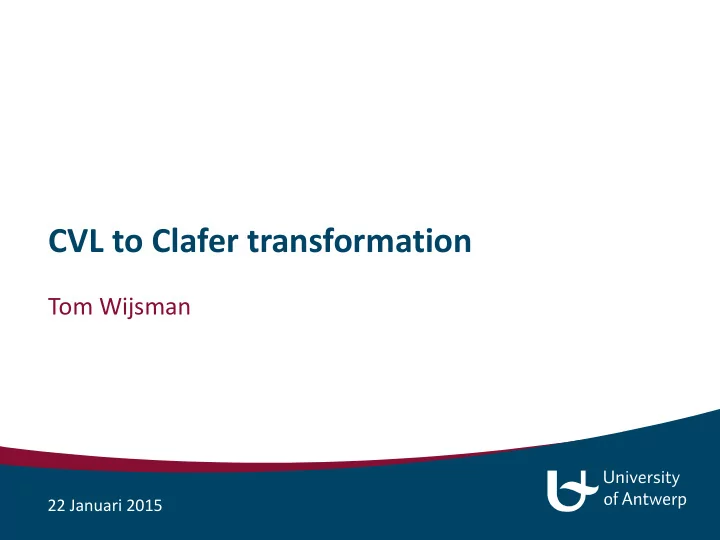

CVL to Clafer transformation Tom Wijsman 22 Januari 2015
Overview 1. CVL to Clafer transformation steps Identify common features for both languages 1. Create abstract and concrete visual syntax for CVL in AToMPM 2. Export metamodel and models from AToMPM to metaDepth 3. Transform (ETL) from CVL to Clafer in metaDepth 4. Generate (EGL) from Clafer in metaDepth to concise Clafer 5. 2. Example 3. Verification 4. Conclusion 5. Future work 2
Chapter 1 CVL to Clafer transformation steps 3
Step 1: Identify common features for both CVL Clafer Variability Specification Class/Feature Type Variability Choice Feature Variability Variable Type Definition Optional VSpec “?” behind the Class/Feature Type Type of Variable “: Type” behind the Class/Feature Type “ xor ” (1..1), “or” (1..*) or “ x..y ” ( xy) Group Cardinality before the Class/Feature Type Children of a VSpec Indented one level deeper than the parent The constraints are custom made and not part of these languages. 4
Step 2: Create abstract and concrete visual syntax 5
Step 2: Create abstract and concrete visual syntax 6
Step 2: Create abstract and concrete visual syntax : Type CVL: Clafer: Example Example : Type 7
Step 2: Create abstract and concrete visual syntax CVL: Clafer: Example Example? 8
Step 2: Create abstract and concrete visual syntax CVL: xor Example Clafer: … or Example … x..y Example … 9
Step 2: Create abstract and concrete visual syntax Custom CVL: [ x OPERATION y ] [ x && y && !z ] Custom Clafer: 10
Step 2: Create abstract and concrete visual syntax Custom CVL: Custom Clafer: x !x Custom CVL: [ lhs OPERATION rhs ] Custom Clafer: 11
Step 3: Export metamodel to metaDepth Model CVLMM { Node Constraint {} Node Link { Node ComparisonConstraint : Constraint{ src : Node; Operator:String = "="; dst : Node; } } Node ChoiceConstraint : Constraint {} Node Root {} Node VSpecToRoot : Link {} Node VSpec {} Node Parent : Link{} Node Variable : VSpec { Node MandatoryChildOf : Link {} Name:String = "Name"; Node OptionalChildOf : Link {} Type:String = "Type"; Node GroupCardinalityToVSpec : Link } {} Node Choice : VSpec { Node LHS : Link {} Name:String = "Name"; Node RHS : Link {} } Node And : Link {} Node GroupCardinality { Node AndNot : Link {} min:String = "0"; } max:String = "*"; } 12
Step 4: Transform from CVL to Clafer in metaDepth Model ClaferMM { • Enumerate all root VSpecs Node Link { src : Node; dst : Node; • Recursively enumerate their children } • Recursively enumerate group cardinalities too Node Root {} Node Clafer { Name:String = ""; • For each VSpec, create a Clafer clafer Optional:boolean = false; Type:String = ""; • CardType:String = ""; For each link between VSpecs, create a Clafer link IsRootElement:boolean = false; } • For each CVL Constraint, create a Clafer constraint Node Constraint { Constraint:String = ""; } • Set the Clafer elements’ parameters accordingly Node ClaferToRoot : Link {} Node ClaferToParent : Link {} Node ConstraintToClafer : Link {} } 13
Step 5: Generate the concise Clafer representation [% for (c in Clafer.all.select(x | x.IsRootElement = true)) { %] • Enumerate the root clafers [%=c.printClafer() %] [%=c.enumChildren() %][% } %] • Recursively enumerate the [% child clafers and constraints @template operation Clafer enumChildren() { • for (cp in ClaferToParent.all.select(x | x.dst = self)) { For each clafer, print parameters %][%=cp.src.printClafer() %] [%=cp.src.enumChildren() %] [% } for (cc in ConstraintToClafer.all.select(x | x.dst = self)) { %][ [%=cc.src.Constraint %] ][%="\n" %][% } } @template operation Clafer printClafer() { %][%=self.printCardType() %][%=self.Name %][%=self.printType() %][%=self.printOptional() %][% } 14
Chapter 2 Example 15
Example (CVL) 16
Example (Clafer) RPGGame Difficulty : real Story or Environment? xor Players Door Singleplayer Name : string? Goal Multiplayer Key Min : integer Trap Max : integer [ Key && Door && !Trap ] [ Min <= Max ] 1..2 Enemies Villain Dragon 17
Chapter 3 Verification 18
Verification 19
Chapter 4 Conclusion 20
Conclusion A common subset of features between CVL and Clafer exists that is large enough for a successful transformation of a large set of CVL models to Clafer. 21
Chapter 5 Future work 22
Future work • Study similarities and difference of instantiation of CVL and Clafer , transforming CVL’s variation points to concepts (constraints) or methods (IG manipulation) in Clafer. • Study CVL constraints (OCL based) and Clafer constraints (Alloy based) with a comparison in order to create a more complete transformation for constraints. These suggestions can be considered projects on their own. 23
Thank you for your attention! Comments and questions are welcome.
Recommend
More recommend